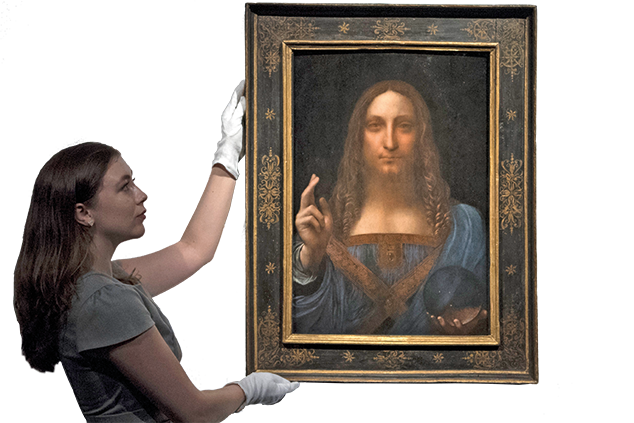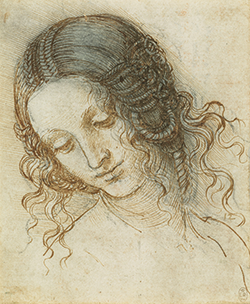Is Leonardo da Vinci overrated?
Leonardo da Vinci’s reputation has come under scrutiny, says Chris Carter. Is the criticism fair?


Last month marked 500 years since Leonardo da Vinci's death. Yet few of the comments about his life that were inspired by the event have been celebratory. First, there was the attention drawn to the relative paucity of his works. Just 20 are known to exist. The artist "was notorious for beginning and never completing artworks", says Jason Daley in Smithsonian magazine. Two neuroscientists, Marco Catani and Paolo Mazzarello, posited a theory in science journal Brain that da Vinci had attention deficit and hyperactive disorder (ADHD). "ADHD could explain aspects of Leonardo's temperament and his strange mercurial genius," said Professor Catani of King's College London.
The $450m question
Then there is the ongoing row over whether Salvator Mundi is the real thing. You may recall that Salvator Mundi was the painting (pictured) that fetched an eye-watering $450m at auction in 2017. So, there's more than just pride at stake. At the Hay literary festival last month, art historian Ben Lewis spilled the beans on the fall-out when he said: "My inside sources at the Louvre tell me that not many curators think this picture is an autograph Leonardo da Vinci." As a sop to the buyer, thought to be Saudi Arabia's Crown Prince Mohammad bin Salman, the world-famous gallery would "exhibit it as workshop'" an offer unlikely to be taken up, as Lewis explained. "If that's the case the owner can't possibly lend it the value will go down to somewhere north of $1.5m." Art critic Waldemar Januszczak won't be sympathetic he has written previously, in The Sunday Times, about how Christie's had "circumnavigated the knowledgeable world of the Old Master collector and headed straight for the dumb f*** with the money".
Germaine Greer is taking a contrarian line too, also at the Hay festival this time on the Mona Lisa. "I remember the first time I saw the Mona Lisa," she said. "I go to the Louvre, get to the room, and see the most wonderful painting which is the Raphael portrait of Baldassare Castiglione... But no one was looking at it. They were all staring at this half-dead woman As for the famous smile, this is what I call the Leonardo smirk'." And The Last Supper? It's "sloppy".
MoneyWeek
Subscribe to MoneyWeek today and get your first six magazine issues absolutely FREE

Sign up to Money Morning
Don't miss the latest investment and personal finances news, market analysis, plus money-saving tips with our free twice-daily newsletter
Don't miss the latest investment and personal finances news, market analysis, plus money-saving tips with our free twice-daily newsletter
Greer's suspicions about that smile appeared to be backed up last week by US scientists, who concluded the famous half-smile was fake, because it is on the right of her face. "We here interpreted the Mona Lisa asymmetric smile as a non genuine smile also thought to occur when the subject lies," said lead author Dr Luca Marsili, a neurologist at the University of Cincinnati.
The da Vinci mystique
So, why all the fuss over Leonardo? After all, the artist "died in relative obscurity, exiled in France, while overshadowed by his rivals Raphael and Michelangelo", say Jean-Pierre Isbouts and Christopher Brown, authors of The Da Vinci Legacy, writing on Artnet News. Rather, say the authors, our familiarity with da Vinci is down to how easily his works were copied using the "first reproducible mass medium: the copper engraving". That's especially true of The Last Supper, thanks to its "sheer monumentality and the relative absence of optical effects and detail".
But the "mystique" of da Vinci was also used to legitimise despotic rulers consider, for example, the story that the artist was "somehow dispatched to the Sforza court of Milan by Lorenzo de' Medici", when, in reality, "Leonardo never enjoyed the patronage of the Medicis".
Louis XVI and Napoleon also both dined out on da Vinci's fame (the latter hung the Mona Lisa in his bedroom). It's still happening today, the authors argue witness the Salvator Mundi purchase by the "absolutist monarchy" that is the House of Saud, which was not without irony, Isbouts and Brown point out: "Imagine the irony of a ruler of the strictest Islamic nation in the world paying nearly half a billion dollars for a portrait of Jesus Christ."
The Renaissance Man still amazes

"The moment you confront the ultimate Renaissance Man, you're hit by 500 years of hyperbole," says Mark Hudson in The Daily Telegraph. "The one place you can get an intimate sense of Leonardo, however, is through his drawings" 200 of which are on display at the new exhibition, Leonardo da Vinci: A Life in Drawing, at the Queen's Gallery (rct.uk), until 13 October.
"The drawings show the subjects that his playful and curious mind ranged over sometimes in a single sheet of paper and frequently of variable quality and also the extent of his mastery of them", says Melanie McDonagh in the Evening Standard.
"Everything about this magnificent presentation of Leonardo's drawings amazes," says Laura Cumming in The Observer. "Although they have been in the Royal Collection since the 1670s, the sheer surprise of them never ceases I doubt I will ever see a more intelligent presentation of Leonardo in my lifetime. Each of these groupings horses, machines, visions of clouds, rock formations, deluges, and so on would have made a whole show in itself."
The British Library in London is also holding an exhibition this summer. Leonardo da Vinci: A Mind in Motion features highlights taken from three of da Vinci's notebooks "to explore the inner workings of his complex mind". The exhibition runs until 8 September (bl.uk).
Get the latest financial news, insights and expert analysis from our award-winning MoneyWeek team, to help you understand what really matters when it comes to your finances.

-
 Investors will reap long-term rewards from UK equities
Investors will reap long-term rewards from UK equitiesOpinion Nick Train, portfolio manager, Finsbury Growth & Income Trust, highlights three UK equities where he’d put his money
-
 The graphene revolution is progressing slowly but surely
The graphene revolution is progressing slowly but surelyEnthusiasts thought the discovery that graphene, a form of carbon, could be extracted from graphite would change the world. They might've been early, not wrong.